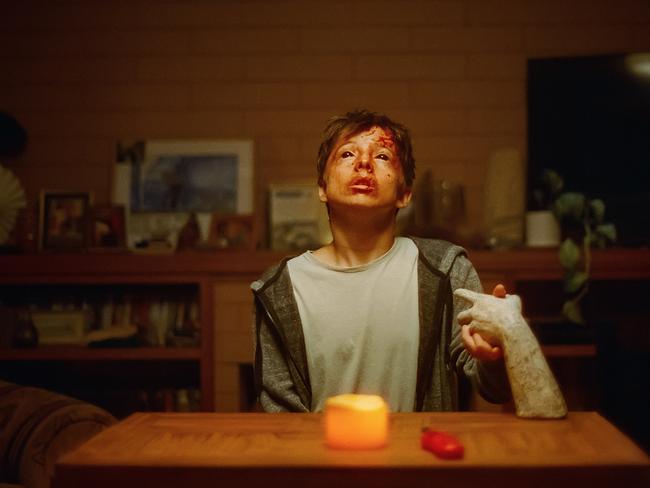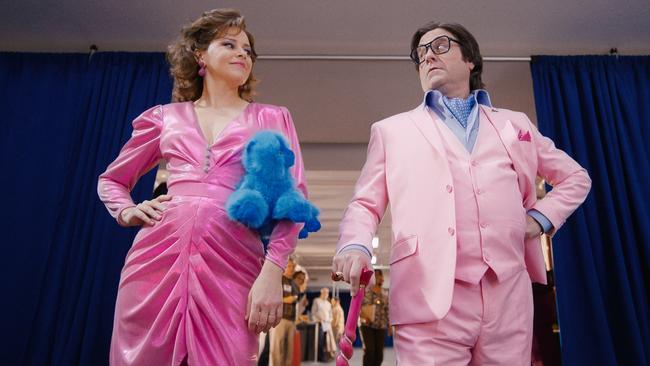Talk to Me: thought-provoking horror from stars of YouTube channel RackaRacka
It’s not a slasher film and doesn’t use jump scares but that doesn’t mean it won’t send your heart racing. The opening scene, centred on two teenage brothers, is terrifying.

Talk To Me (MA15+)
In cinemas
★★★½
If you like horror flicks but are looking for something different to Freddy Krueger slash Jason Voorhees slash Michael Myers, then check out the Australian creep show Talk To Me. It is boldly original and finely acted by the young cast.
It’s the big screen directorial debut of Adelaide-born twins Danny and Michael Philippou, who stamped themselves on the horror patch via their popular YouTube channel RackaRacka.
It’s not a slasher film and doesn’t use jump scares but that doesn’t mean it won’t send your heart racing. The opening scene, centred on two teenage brothers, is terrifying.
What happens between them, during a teen party somewhere in suburban Australia, defies explanation. We want – need – an answer but we have to wait.
Instead the story, written by Danny Philippou and Bill Hinzman, moves onto the main characters: a group of late-teen high school students.
Mia (Sophie Wilde) lives in the same house as her friend Jade (Alexandra Jensen) and Jade’s younger brother Riley (Joe Bird). We learn that Mia’s mother killed herself. Then we learn there may be more to it than that.
READ MORE: Barbie review: This film and Margot Robbie deserve Oscars buzz | Oppenheimer review: All-star cast steals the show | Donald Trump, stuffed toys and the ‘poisoning of America’
Jade and Joe’s mother Sue (Miranda Otto) is a hard-nosed single parent. “My daughter,’’ she says to Jade’s boyfriend Daniel (Otis Dhanji). “Vagina prohibited.”
Mia, Jade and Daniel hook up with some friends who conduct – and film on their smartphones – what oldies might call a seance. Riley tags along. The group is led by tough-talking Hayley (Zoe Terakes from the TV prison drama Wentworth).
They have what looks like the plaster cast of a hand. One of them says it’s the embalmed hand of a psychic who could communicate with the dead. Another says he was told it was the hand of a satanist.
Here’s what they do. Someone is strapped into a chair. They join hands with the hand. They say “Talk to me”. Then they say the words that can’t be unsaid, “I let you in”.
There’s a time limit of 90 seconds. They must not hold the hand any longer than that or those invited in might stay.
Mia has a go and we see what she sees. It’s frightening. She is physically transfigured. “He’ll split ya. Run, run, run, run, run,’’ she screams. Wilde, recently in the Sam Neill-Christoph Waltz film A Portable Door, is brilliant.
When Riley, who is only 15, persuades them to let him have a go – only for 60 seconds – what happens to him changes everything. Bird, too, is terrific in this challenging role.
This film premiered at the Sundance Film Festival in January. It’s a horror movie where the source of the horror may be what it seems – dead people summoned back to some sort of life – or may be something unsupernatural such as a young person struggling to cope with loss and trauma and how this manifests. Or, or course, it may be both.
There’s no clear cut answer and I like that in a film. As I watched, this question came to mind: what would be worse when one dies, to be sent straight to eternal hell or to be stranded in purgatory forever?
That depends a bit on what constitutes purgatory. The most disturbing scene in this thought-provoking horror movie about the continuous circle of life and death, involving young Riley, had me voting for hell.
The Beanie Bubble (M)
Apple TV+
★★★
“We didn’t set out to make America lose its mind but that’s what happened.” So says Robbie (Elizabeth Banks) early in the semi-true drama The Beanie Bubble.
It’s 1983 and unhappily married Robbie starts a Chicago-based business – and an affair – with single Ty Warner (Zack Galifianakis), a toy salesman.
They plan to sell plush toy animals filled with plastic pellets – the beanies of the title – and Ty has two ideas on how to make them different.
First the toys are under-stuffed, making them softer and more pliant so kids can put them in poses.
Second some are produced in limited editions, making them semi-rare.
After a slow start, the beanie babies boom. Soon parents pay $US20 ($30) for a second-hand soft critter that had an original price tag of $US5.

And that’s before the internet becomes involved. When it does, the nascent online auction site eBay becomes a go-to site and some people pay thousands for a stuffed pink platypus.
That comes in the 1990s. Ty, still single, is super rich and in a new relationship with divorced Sheila (Australia’s Sarah Snook), who has two pre-teen daughters.
At the same time, Maya (Australia’s Geraldine Viswanathan) ditches her medical studies and lands a minimum wage job at Ty Inc. She uses her tech smarts to “make everyone greedy for what we sell”.
This movie joins the recent balance sheet covering 80s and 90s corporate America, following Air (sports shoes) and Tetris (video games). BlackBerry (smartphones), set a little later and starting in Canada, will be released in August.
It’s semi-true by admission. The source material is Zac Bissonette’s nonfiction book from 2015, The Great Beanie Baby Bubble. However the 110-minute movie opens with a disclaimer: “There are parts of the truth you can’t make up. The rest, we did.”
The question is what’s true and what’s invented? The bubble is true. It’s estimated that at one point half of all American households owned beanie babies. News clips, which there should be more of, show adults arguing in toy stores and divorcing couples fighting over their collections.
The co-directors are novelist and screenwriter Kristin Gore, daughter of the former US vice president, and her rock musician husband Damian Kulash.
Gore, who wrote the script, plays a straight bat politically. The downside of Reaganomics is mentioned – “It’s the perfect time to sell a little joy,’’ Robbie says – as is the impeachment trial of her dad’s former boss Bill Clinton.
I suspect she plays a more satirical bat with Ty Warner, who is aged 78 and still a billionaire. He’s presented as an eccentric, narcissistic man-child who takes credit for other people’s – in this version, women’s – achievements.
“Ty would tell you he did it all,’’ Robbie says, “but that’s bullshit.”
Galifianakas, best known for The Hangover trilogy, is brilliant in the role. “I only want to speak to Oprah Winfrey,’’ he says as the media comes calling. Viswanathan is also great. You may have seen her alongside Hugh Jackman and Allison Janney in the powerful 2019 drama Bad Education. She’s a young actor to watch.
The three women – named Robbie, Sheila and Maya in this film – are real people who were part of Ty’s life and business. You can read up on them and Ty if you’re of a mind to, as I was after seeing this movie.
It is a fascinating story, hampered a bit in this telling by the frequent switching between the two main time frames.
Robbie is right that the beanie bubble represents a mad moment, as did tulip mania in 17th-century Holland, and other must-have investments before and since.
eBay is still around but lots of other online start-ups, such as Pets.com, did not survive the bursting of the dotcom bubble in 2000. I thought the film might have made more of that.
It’s interesting that the filmmakers decided to turn this real life story into a sort of #MeToo movie. I’m not saying they are wrong to do so. Yet, personally, a documentary account of this brief mass delusion would be more interesting and maybe – just maybe – help us dodge bubbles in the future.


To join the conversation, please log in. Don't have an account? Register
Join the conversation, you are commenting as Logout